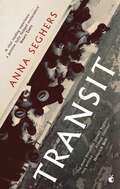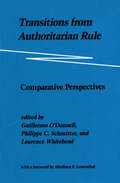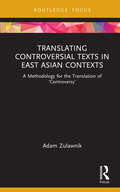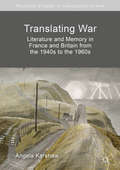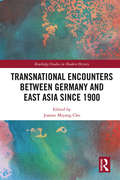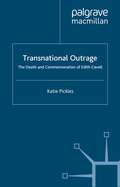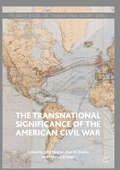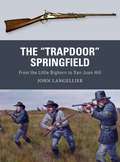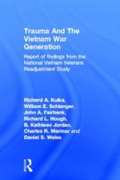- Table View
- List View
Transforming Violent Conflict: Radical Disagreement, Dialogue and Survival (Routledge Studies in Peace and Conflict Resolution)
by Oliver RamsbothamThis book investigates intractable conflicts and their main verbal manifestation - radical disagreement – and explores what can be done when conflict resolution fails. The book identifies agonistic dialogue - dialogue between enemies - as the key to linguistic intractability. It suggests how agonistic dialogue can best be studied, explored, understood and managed even in the most severe political conflicts when negotiation, mediation, problem solving, dialogue for mutual understanding, and discourse ethics are unsuccessful. This approach of viewing radical disagreement as the central topic of analysis and conflict management is a new innovation in this field, and also supplements and enhances existing communicative transformational techniques. It also has wider implications for cognate fields, such as applied ethics, democratic theory, cultural studies and the philosophy of difference. This book will be of great interest to students of conflict resolution, peace and conflict studies, ethnic conflict and International Relations in general. Oliver Ramsbotham is Emeritus Professor of Conflict Resolution at the University of Bradford, UK, Chair of the Oxford Research Group, President of the Conflict Research Society and co-author of Conflict Resolution in Contemporary Conflict.
Transforming Violent Conflict: Radical Disagreement, Dialogue and Survival (Routledge Studies in Peace and Conflict Resolution)
by Oliver RamsbothamThis book investigates intractable conflicts and their main verbal manifestation - radical disagreement – and explores what can be done when conflict resolution fails. The book identifies agonistic dialogue - dialogue between enemies - as the key to linguistic intractability. It suggests how agonistic dialogue can best be studied, explored, understood and managed even in the most severe political conflicts when negotiation, mediation, problem solving, dialogue for mutual understanding, and discourse ethics are unsuccessful. This approach of viewing radical disagreement as the central topic of analysis and conflict management is a new innovation in this field, and also supplements and enhances existing communicative transformational techniques. It also has wider implications for cognate fields, such as applied ethics, democratic theory, cultural studies and the philosophy of difference. This book will be of great interest to students of conflict resolution, peace and conflict studies, ethnic conflict and International Relations in general. Oliver Ramsbotham is Emeritus Professor of Conflict Resolution at the University of Bradford, UK, Chair of the Oxford Research Group, President of the Conflict Research Society and co-author of Conflict Resolution in Contemporary Conflict.
Transforming Warriors: The Ritual Organization of Military Force (Cass Military Studies)
by Peter Haldén Peter JacksonThis volume offers an interdisciplinary study of how different cultures have sought to transform individuals into warriors. War changes people, however a less explored question is how different societies want people to change as they are turned into warriors. When societies go to war they recognize that a boundary is being crossed. The participants are expected to do things that are otherwise prohibited, or at least governed by different rules. This edited volume analyses how different cultures have conceptualized the transformations of an individual passing from a peacetime to a wartime existence to become an active warrior. Despite their differences, all societies grapple with the same question: how much of the individual’s peace-self should be and can be retained in the state of war? The book explores cases such as the Nordic berserkers, the Japanese samurai, and European knights, as well as modern soldiers in Germany, Liberia, and Sweden. It shows that archaic and modern societies are more similar than we usually think: both kinds of societies use myths, symbols, and rituals to create warriors. Thus, this volume seeks to redefine theories of modernization and secularization. It shows that military organizations need to take myths, symbols, and rituals seriously in order to create effective units. This book will be of much interest to students of military studies, war studies, sociology, religion, and international relations in general.
Transforming Warriors: The Ritual Organization of Military Force (Cass Military Studies)
by Peter Haldén Peter JacksonThis volume offers an interdisciplinary study of how different cultures have sought to transform individuals into warriors. War changes people, however a less explored question is how different societies want people to change as they are turned into warriors. When societies go to war they recognize that a boundary is being crossed. The participants are expected to do things that are otherwise prohibited, or at least governed by different rules. This edited volume analyses how different cultures have conceptualized the transformations of an individual passing from a peacetime to a wartime existence to become an active warrior. Despite their differences, all societies grapple with the same question: how much of the individual’s peace-self should be and can be retained in the state of war? The book explores cases such as the Nordic berserkers, the Japanese samurai, and European knights, as well as modern soldiers in Germany, Liberia, and Sweden. It shows that archaic and modern societies are more similar than we usually think: both kinds of societies use myths, symbols, and rituals to create warriors. Thus, this volume seeks to redefine theories of modernization and secularization. It shows that military organizations need to take myths, symbols, and rituals seriously in order to create effective units. This book will be of much interest to students of military studies, war studies, sociology, religion, and international relations in general.
Transit (Virago Modern Classics #807)
by Anna SeghersINTRODUCED BY STUART EVERS: 'A genuine, fully fledged masterpiece of the twentieth century; one that remains just as terrifyingly relevant and truthful in the twenty-first'An existential, political, literary thriller first published in 1944, Transit explores the plight of the refugee with extraordinary compassion and insight. Having escaped from a Nazi concentration camp in Germany and a work camp in Rouen, the nameless narrator finds himself in the dusty seaport of Marseille. Along the way he was asked to deliver a letter to Weidel, a writer in Paris whom he discovered had killed himself as the Nazis entered the city. Now he is in search of the dead man's wife. He carries Weidel's suitcase, which contains an unfinished novel - and a letter securing Weidel a visa to escape France.Assuming the name Seidler - though the authorities think he is in fact Weidel - he goes from cafe to cafe looking for Marie, who is in turn anxiously searching for her husband. As Seidler converses with refugees over pizza and wine, their stories gradually break down his ennui, bringing him a deeper awareness of the transitory world they inhabit as they wait and wait for that most precious of possessions: transit papers.'This novel, completed in 1942, is in my opinion the most beautiful Seghers has written . . . almost flawless' - Heinrich Boll
Transitions from Authoritarian Rule: Comparative Perspectives
by Guillermo O’Donnell Philippe C. Schmitter Laurence WhiteheadAn array of internationally noted scholars examines the process of democratization in Southern Europe and Latin America. The authors provide new interpretations of both current and historical efforts of nations to end periods of authoritarian rule and to initiate transition to democracy, efforts that have met with widely varying degrees of success and failure. Extensive case studies of individual countries, a comparative overview, and a synthesis conclusions offer important insights for political scientists, students, and all concerned with the prospects for democracy. In Volume 3, despite the unique contexts of transitions in individual countries, significant points of comparison emerge — such as the influence of foreign nations and the role of agents outside the government. These analyses explore both intra- and interregional similarities and differences.
Translating Controversial Texts in East Asian Contexts: A Methodology for the Translation of ‘Controversy’ (Routledge Advances in Translation and Interpreting Studies)
by Adam ZulawnikZulawnik focuses on the broad concept of ‘controversy’ and issues pertaining to the translation of politically and historically controversial texts in East Asia. The research methodology is exemplified through a case study in the form of the author’s translation of the best-selling Japanese graphic novel (manga) Manga Kenkanryū (Hate Hallyu: The Comic) by Sharin Yamano (2005), a work that has been problematised as an attack on South Korean culture and the Korean Wave. Issues analysed and discussed in the research include translation risk, ethics, a detailed methodology for the translation of so-called controversial texts exemplified through numerous thematically divided examples from the translation of the chosen Japanese text, as well as examples from a Korean language equivalent (Manhwa Hyeomillyu – Hate Japanese Wave), and definition and contextualisation of the concept of ‘controversy’. There has been limited research in the field of translation studies, which seeks to exemplify potential pragmatic approaches for the translation of politically-charged texts, particularly in multi-modal texts such as the graphic novel. It is hoped that Zulawnik’s research will serve both as a valuable source when examining South Korea–Japan relations and a theoretical and methodological base for further research and the development of an online augmented translation space with devices specifically suited for the translation of multi-modal texts such as – but not limited to – graphic novels and visual encyclopaedias.
Translating Controversial Texts in East Asian Contexts: A Methodology for the Translation of ‘Controversy’ (Routledge Advances in Translation and Interpreting Studies)
by Adam ZulawnikZulawnik focuses on the broad concept of ‘controversy’ and issues pertaining to the translation of politically and historically controversial texts in East Asia. The research methodology is exemplified through a case study in the form of the author’s translation of the best-selling Japanese graphic novel (manga) Manga Kenkanryū (Hate Hallyu: The Comic) by Sharin Yamano (2005), a work that has been problematised as an attack on South Korean culture and the Korean Wave. Issues analysed and discussed in the research include translation risk, ethics, a detailed methodology for the translation of so-called controversial texts exemplified through numerous thematically divided examples from the translation of the chosen Japanese text, as well as examples from a Korean language equivalent (Manhwa Hyeomillyu – Hate Japanese Wave), and definition and contextualisation of the concept of ‘controversy’. There has been limited research in the field of translation studies, which seeks to exemplify potential pragmatic approaches for the translation of politically-charged texts, particularly in multi-modal texts such as the graphic novel. It is hoped that Zulawnik’s research will serve both as a valuable source when examining South Korea–Japan relations and a theoretical and methodological base for further research and the development of an online augmented translation space with devices specifically suited for the translation of multi-modal texts such as – but not limited to – graphic novels and visual encyclopaedias.
Translating War: Literature and Memory in France and Britain from the 1940s to the 1960s (Palgrave Studies in Languages at War)
by Angela KershawThis book examines the role played by the international circulation of literature in constructing cultural memories of the Second World War. War writing has rarely been read from the point of view of translation even though war is by definition a multilingual event, and knowledge of the Second World War and the Holocaust is mediated through translated texts. Here, the author opens up this field of research through analysis of several important works of French war fiction and their English translations. The book examines the wartime publishing structures which facilitated literary exchanges across national borders, the strategies adopted by translators of war fiction, the relationships between translated war fiction and dominant national memories of the war, and questions of multilingualism in war writing. In doing so, it sheds new light on the political and ethical questions that arise when the trauma of war is represented in fiction and through translation. This engaging work will appeal to students and scholars of translation, cultural memory, war fiction and Holocaust writing.
Transnational Encounters between Germany and East Asia since 1900 (Routledge Studies in Modern History)
by Joanne Miyang ChoThis volume contributes to an emerging field of Asian German Studies by bringing together cutting-edge scholarship from international scholars working in a variety of disciplines. The chapters survey transnational encounters between Germany and East Asia since 1900. By rejecting traditional dichotomies between the East and the West or the colonizer and the colonized, these essays highlight connectedness and hybridity. They show how closely Germany and East Asia cooperated and negotiated the challenges of modernity in a range of topics, such as politics, history, literature, religion, environment, architecture, sexology, migration, and sports.
Transnational Encounters between Germany and East Asia since 1900 (Routledge Studies in Modern History)
by Joanne Miyang ChoThis volume contributes to an emerging field of Asian German Studies by bringing together cutting-edge scholarship from international scholars working in a variety of disciplines. The chapters survey transnational encounters between Germany and East Asia since 1900. By rejecting traditional dichotomies between the East and the West or the colonizer and the colonized, these essays highlight connectedness and hybridity. They show how closely Germany and East Asia cooperated and negotiated the challenges of modernity in a range of topics, such as politics, history, literature, religion, environment, architecture, sexology, migration, and sports.
Transnational Outrage: The Death and Commemoration of Edith Cavell
by K. PicklesThe execution of British matron Edith Cavell by occupying German forces was portrayed by the allies as one of the key atrocities of the Great War. This book recovers and interprets the worldwide reaction to Cavell's death, exploring its contextual relationship within imperial and international history, as well women's history and gender history.
Transnational Security
by Marie-Helen MarasGlobalization and the easy movement of people, weapons, and toxins across borders has transformed security into a transnational phenomenon. Preventing transnational security threats has proven to be a very difficult challenge for governments and institutions around the world. Transnational Security addresses these issues, which are at the forefront
The Transnational Significance of the American Civil War (Palgrave Macmillan Transnational History Series)
by Jörg Nagler Don H. Doyle Marcus GräserThis volume of pioneering essays brings together an impressive array of well-established and emerging historians from Europe and the United States whose common endeavor is to situate America’s Civil War within the wider framework of global history. These essays view the American conflict through a fascinating array of topical prisms that will take readers beyond the familiar themes of U. S. Civil War history. They will also take readers beyond the national boundaries that typically confine our understanding of this momentous conflict. The history of America’s Civil War has typically been interpreted within a familiar national narrative focusing on the internal discord between North and South over the future of slavery in the United States.
Transnational Soldiers: Foreign Military Enlistment in the Modern Era
by Nir Arielli and Bruce CollinsWarfare in the modern era has often been described in terms of national armies fighting national wars. This volume challenges the view by examining transnational aspects of military mobilization from the eighteenth century to the present. Truly global in scope, it offers an alternative way of reading the military history of the last 250 years.
The Transnational World of the Cominternians
by B. StuderThe 'Cominternians' who staffed the Communist International in Moscow from its establishment in 1919 to its dissolution in 1943 led transnational lives and formed a cosmopolitan but closed and privileged world. The book tells of their experience in the Soviet Union through the decades of hope and terror.
The "Trapdoor" Springfield: From the Little Bighorn to San Juan Hill (Weapon)
by Steve Noon John Langellier Alan GillilandIntended to replace the proliferation of different small arms fielded by US forces during the American Civil War, the “Trapdoor Springfield” was designed in 1865–66 by Erskine S. Allin. Using metallic cartridges, it could be loaded in a single action, increasing the number of shots per minute as much as fivefold. The new weapon quickly proved its worth in two separate incidents in August 1867: small groups of US soldiers and civilians armed with the trapdoor repulsed numerically superior Native American contingents. A simple and cost-effective weapon, it was used, along with its variants in every US conflict in the three decades after the Civil War, especially on the American frontier.Drawing upon first-hand accounts from US soldiers, their Native American opponents, and users such as buffalo hunters, this is the story of the “Trapdoor Springfield”, one of the defining weapons of the Indian Wars.
The "Trapdoor" Springfield: From the Little Bighorn to San Juan Hill (Weapon #62)
by Steve Noon John Langellier Alan GillilandIntended to replace the proliferation of different small arms fielded by US forces during the American Civil War, the “Trapdoor Springfield” was designed in 1865–66 by Erskine S. Allin. Using metallic cartridges, it could be loaded in a single action, increasing the number of shots per minute as much as fivefold. The new weapon quickly proved its worth in two separate incidents in August 1867: small groups of US soldiers and civilians armed with the trapdoor repulsed numerically superior Native American contingents. A simple and cost-effective weapon, it was used, along with its variants in every US conflict in the three decades after the Civil War, especially on the American frontier.Drawing upon first-hand accounts from US soldiers, their Native American opponents, and users such as buffalo hunters, this is the story of the “Trapdoor Springfield”, one of the defining weapons of the Indian Wars.
Trauma And The Vietnam War Generation: Report Of Findings From The National Vietnam Veterans Readjustment Study (PDF)
by Richard A. Kulka Alan CranstonFirst published in 1990. Routledge is an imprint of Taylor & Francis, an informa company.
Trauma And The Vietnam War Generation: Report Of Findings From The National Vietnam Veterans Readjustment Study
by Richard A. Kulka Alan CranstonFirst published in 1990. Routledge is an imprint of Taylor & Francis, an informa company.
Trauma, Experience and Narrative in Europe after World War II (Palgrave Studies in the History of Experience)
by Ville Kivimäki Peter LeeseThis book promotes a historically and culturally sensitive understanding of trauma during and after World War II. Focusing especially on Eastern and Central Europe, its contributors take a fresh look at the experiences of violence and loss in 1939–45 and their long-term effects in different cultures and societies. The chapters analyze traumatic experiences among soldiers and civilians alike and expand the study of traumatic violence beyond psychiatric discourses and treatments. While acknowledging the problems of applying a present-day medical concept to the past, this book makes a case for a cultural, social and historical study of trauma. Moving the focus of historical trauma studies from World War I to World War II and from Western Europe to the east, it breaks new ground and helps to explain the troublesome politics of memory and trauma in post-1945 Europe all the way to the present day. This book is an outcome of a workshop project ‘Historical Trauma Studies,’ funded by the Joint Committee for the Nordic Research Councils in the Humanities and Social Sciences (NOS-HS) in 2018–20.Chapters 4, 5 and 6 are available open access under a Creative Commons Attribution 4.0 International License via link.springer.com.
Trauma, Postmodernism and the Aftermath of World War II
by P. CrosthwaiteThe first sustained study of the relationship between Anglo-American postmodernist fiction and the Second World War, Crosthwaite demonstrates that postmodernism has not abandoned history but has rather reformulated it in terms of trauma that is traceable, time and again, to the catastrophes of the 1940s.
Trauma, Primitivism and the First World War: The Making of Frank Prewett
by Joy PorterThis book examines the extraordinary life of Frank “Toronto” Prewett and the history of trauma, literary expression, and the power of self-representation after WWI. Joy Porter sheds new light on how the First World War affected the Canadian poet, and how war-induced trauma or “shell-shock” caused him to pretend to be an indigenous North American. Porter investigates his influence of, and acceptance by, some of the most significant literary figures of the time, including Siegfried Sassoon, Edmund Blunden, Wilfred Owen and Robert Graves.In doing so, Porter skillfully connects a number of historiographies that usually exist in isolation from one another and rarely meet. By bringing together a history of the WWI era, early twentieth century history, Native American history, the history of literature, and the history of class Porter expertly crafts a valuable contribution to the field.
Trauma, Primitivism and the First World War: The Making of Frank Prewett
by Joy PorterThis book examines the extraordinary life of Frank “Toronto” Prewett and the history of trauma, literary expression, and the power of self-representation after WWI. Joy Porter sheds new light on how the First World War affected the Canadian poet, and how war-induced trauma or “shell-shock” caused him to pretend to be an indigenous North American. Porter investigates his influence of, and acceptance by, some of the most significant literary figures of the time, including Siegfried Sassoon, Edmund Blunden, Wilfred Owen and Robert Graves.In doing so, Porter skillfully connects a number of historiographies that usually exist in isolation from one another and rarely meet. By bringing together a history of the WWI era, early twentieth century history, Native American history, the history of literature, and the history of class Porter expertly crafts a valuable contribution to the field.
Trauma, Religion and Spirituality in Germany during the First World War
by Jason CrouthamelThis book explores the impact of violence on the religious beliefs of front soldiers and civilians in Germany during the First World War. The central argument is that religion was the main prism through which men and women in the Great War articulated and processed trauma. Inspired by trauma studies, the history of emotions, and the social and cultural history of religion, this book moves away from the history of clerical authorities and institutions at war and instead focuses on the history of religion and war 'from below.' Jason Crouthamel provides a fascinating exploration into the language and belief systems used by ordinary people to explain the inexplicable. From Judeo-Christian traditions to popular beliefs and 'superstitions,' German soldiers and civilians depended on a malleable psychological toolbox that included a hybrid of ideas stitched together using prewar concepts mixed with images or experiences derived from the surreal environment of modern combat. Perhaps most interestingly, studying the front experience exposes not only lived religion, but also how religious beliefs are invented. Front soldiers in particular constructed new, subjective spiritual and religious concepts based on encounters with industrialized weapons, the sacred experience of comradeship, and immersion in mass death, which profoundly altered their sense of self and the supernatural. More than just a coping mechanism, religious language and beliefs enabled victims, and perpetrators, of violence to narrate concepts of psychological renewal and rebirth. In the wake of defeat and revolution, religious concepts shaped by the war experience also became a cornerstone of visions for radical political movements, including the National Socialists, to transform a shattered and embittered German nation.Making use of letters between soldiers and civilians, diaries, memoirs and front newspapers, Trauma, Religion and Spirituality in Germany during the First World War offers a unique glimpse into the belief systems of men and women at a turning point in European history.


